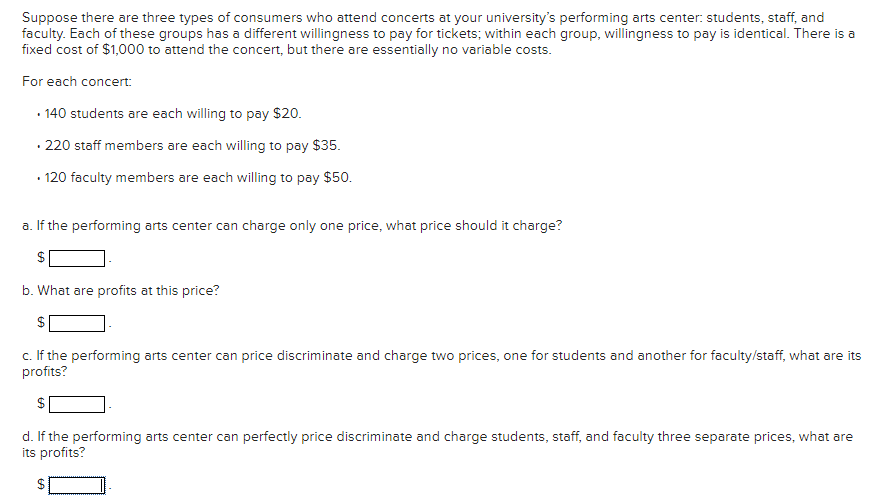Suppose there are three types of consumers who attend concerts at your university's performing arts center: students, staff, and faculty. Each of these groups has a different willingness to pay for tickets; within each group, willingness to pay is identical. There is a fixed cost of $1,000 to attend the concert, but there are essentially no variable costs. For each concert: . 140 students are each willing to pay $20. .220 staff members are each willing to pay $35. • 120 faculty members are each willing to pay $50. a. If the performing arts center can charge only one price, what price should it charge? b. What are profits at this price? c. If the performing arts center can price discriminate and charge two prices, one for students and another for faculty/staff, what are its profits? d. If the performing arts center can perfectly price discriminate and charge students, staff, and faculty three separate prices, what are its profits? (A
Suppose there are three types of consumers who attend concerts at your university's performing arts center: students, staff, and faculty. Each of these groups has a different willingness to pay for tickets; within each group, willingness to pay is identical. There is a fixed cost of $1,000 to attend the concert, but there are essentially no variable costs. For each concert: . 140 students are each willing to pay $20. .220 staff members are each willing to pay $35. • 120 faculty members are each willing to pay $50. a. If the performing arts center can charge only one price, what price should it charge? b. What are profits at this price? c. If the performing arts center can price discriminate and charge two prices, one for students and another for faculty/staff, what are its profits? d. If the performing arts center can perfectly price discriminate and charge students, staff, and faculty three separate prices, what are its profits? (A
Chapter6: Demand Relationships Among Goods
Section: Chapter Questions
Problem 6.5P
Related questions
Question
do fast

Transcribed Image Text:Suppose there are three types of consumers who attend concerts at your university's performing arts center: students, staff, and
faculty. Each of these groups has a different willingness to pay for tickets; within each group, willingness to pay is identical. There is a
fixed cost of $1,000 to attend the concert, but there are essentially no variable costs.
For each concert:
.
140 students are each willing to pay $20.
.220 staff members are each willing to pay $35.
•
120 faculty members are each willing to pay $50.
a. If the performing arts center can charge only one price, what price should it charge?
b. What are profits at this price?
c. If the performing arts center can price discriminate and charge two prices, one for students and another for faculty/staff, what are its
profits?
d. If the performing arts center can perfectly price discriminate and charge students, staff, and faculty three separate prices, what are
its profits?
(A
AI-Generated Solution
Unlock instant AI solutions
Tap the button
to generate a solution
Recommended textbooks for you


Principles of Economics 2e
Economics
ISBN:
9781947172364
Author:
Steven A. Greenlaw; David Shapiro
Publisher:
OpenStax

Exploring Economics
Economics
ISBN:
9781544336329
Author:
Robert L. Sexton
Publisher:
SAGE Publications, Inc


Principles of Economics 2e
Economics
ISBN:
9781947172364
Author:
Steven A. Greenlaw; David Shapiro
Publisher:
OpenStax

Exploring Economics
Economics
ISBN:
9781544336329
Author:
Robert L. Sexton
Publisher:
SAGE Publications, Inc

Economics (MindTap Course List)
Economics
ISBN:
9781337617383
Author:
Roger A. Arnold
Publisher:
Cengage Learning
